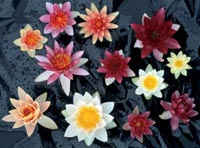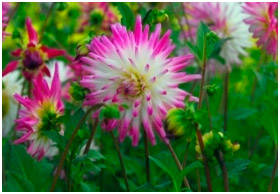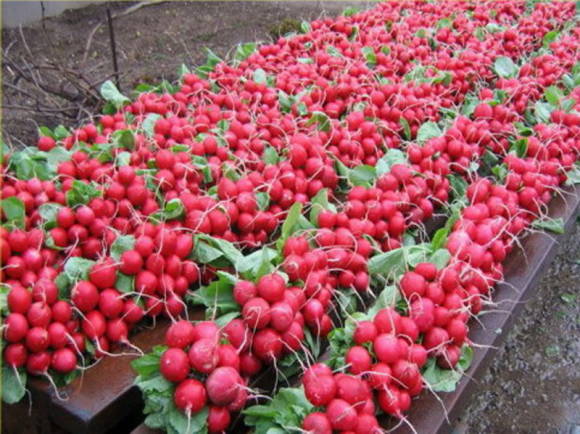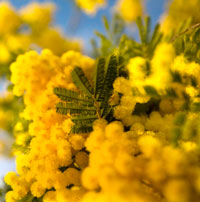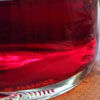
Many delphiniums have long attracted attention as ornamental plants. However, initially only annuals were grown in the gardens. Then, from the 18th century, they lost special interest in them, since perennial delphiniums began to be introduced into the culture. The creation of cultural forms dates back to the second half of the 19th century. The first varieties were obtained in France by V. Lemoine, and in England by Gibson. In the Soviet Union, a great deal of work was done by N.I. Malyutin and A.G. Markov.
The cultivated garden forms and varieties of the hybrid delphinium originated as a result of multiple crosses of the high (Delphinium elatum) and large-flowered delphinium (Delphinium grandiflorum).
Delphinium hybrid is one of the most undemanding and easy-to-grow plants. It is valued not only for its decorative properties, but also for its winter hardiness, drought resistance, unpretentiousness and ease of reproduction. It can grow in one place for 8-10 years.
 |  |  |
Growing a delphinium
Planting site and soil... Delphiniums have a strong root system, so deep tillage is required before planting. On loose, slightly acidic substrates filled with peat, plants live longer than on dense loams and chernozems. Sandy soils are unsuitable, as they dry out quickly in the summer. Best of all, the delphinium develops and blooms on soils abundantly fertilized with humus, well-cultivated and in sunny areas. Delphinium also grows in partial shade, some of its varieties fade in the sun.
Watering... Prefers deep, clayey and loamy soils, moderately moist, but not wet. During the summer, it is necessary to regularly water the plants at the root so that water does not get on the leaves and flowers, which can lead to fungal diseases. Plants are especially sensitive to lack of moisture during the budding period. In dry weather, abundant watering is necessary. Each plant needs about 60 liters of water during the growing season.
Loosening... When leaving, the soil should be loosened to a depth of no more than 5 cm so as not to damage the small roots that grow at a great distance from the base of the bush.
 |  |
Top dressing... During the growing season, it is necessary to carry out several dressings. The first is carried out in April, the snow will melt a little, or it is possible over the snow, so that the nutrients from the melt water get to the plants. Complete complex fertilizer is applied. At the moment of flower brush formation (end of May-June), plants need potassium; during the budding period, foliar feeding with boron can be carried out at the rate of 0.02 g of boric acid per 1 liter of water (the solution must be prepared the day before use). Fertilizing in August is not recommended because this stimulates the growth of young shoots, and they will not have time to prepare for winter.
Pruning... For normal flowering in spring, it is recommended to remove some of the weakest shoots, leaving 3–6 strong ones on the bush. The removed shoots can be used for cuttings. After flowering, if you do not need seeds, the inflorescences should be cut off, leaving the stem with leaves until new shoots form. In August-September, delphiniums can bloom a second time. With the onset of frost, all stems are cut at a height of 20-30 cm from the surface.

Reproduction of delphinium
Delphinium is propagated by seeds, dividing the rhizome and grafting. Sowing seeds should be carried out in the fall, because seeds quickly lose their germination and germinate better after stratification, i.e. cold temperature treatments. In the spring they give amicable shoots. Seedlings grow quickly, in the 4th month they reach half their normal height and in August they can bloom. The next year, the plants are fully formed and bloom at their normal times.
When propagating by seeds, it must be borne in mind that not all varieties retain their high decorative qualities. When planting several varieties, it is necessary to observe spatial isolation so that there is no cross-pollination.
Vegetative propagation is more reliable for the purity of the variety.For division, take 3-4-year-old plants. To do this, in spring or autumn, rhizomes are dug out of the ground, cut with a knife between young shoots or buds of renewal. Each part must have at least one shoot or bud and healthy roots. Places of the cut are sprinkled with crushed coal.
The plots are planted in a prepared place so that the upper part of the rhizome is 1–2 cm below the soil surface. The spring division of the bushes is the most favorable, and the survival rate is high.
Cuttings are carried out in the spring, when the plants reach a height of no more than 8 cm. Cut with a sharp knife at the very root so that the stems are not hollow. Sprinkle the cut with crushed coal. The length of the cutting is 5–6 cm, the planting depth is 2 cm. The cuttings are planted in a mixture of greenhouse, turf soil and sand, after planting, watered and shaded. At a temperature of + 20 ... + 25 ° C, they take root in 15–20 days.
 |  |  |
Fighting delphinium powdery mildew
In culture, delphiniums are often affected by powdery and downy mildew. A white bloom appears on the stems, leaves, flowers, which greatly reduces the decorative effect of the plant. Young shoots are more affected - their growth stops, and the plants may die.
When the first signs of the disease appear, it is necessary to treat the plants with a copper-soap solution (for 10 liters of water - 20 g of copper sulfate and 200-300 g of green soap) or a solution of caustic soda (for 10 liters of water - 40 g of salt and 200 g of soap), spraying should be carried out in 8-10 days, until the complete disappearance of the disease.
Delphiniums are widely used in floriculture - they decorate any garden, both singly and in groups.
"Ural gardener", No. 32, 2019



